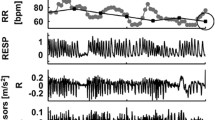Abstract
Two different ways of monitoring respiration in the neonatal period are compared: Detection of the movements of the thorax and abdomen with a mercury-in-rubber strain gauge and the apnoea-alarm mattress.
For routine clinical purposes the apnoea-alarm has proved to be a reliable help for the detection of periods of apnoea. The respiration movements are transformed to an audible signal which can be followed everywhere in the wardroom without watching the infant—and even in other rooms with an extension. It gives an alarm if the respiration stops for longer than a preset time. As an apnoea-alarm the instrument is as perfect as one can expect. It is well designed, easy to use and foolproof. Besides it is cheap for its capability.
Sommaire
On compare deux systèmes différents pour la surveillance de la respiration dans la période néonatale. La détection des mouvements du thorax et de l'abdomen avec un tensiomètre à mercure, en caoutchouc, et le matelas d'alerte de danger d'apnée.
Pour buts cliniques de routine, l'alerte d'apnée a été prouvée d'être une aide digne de foi pour la détection de périodes d'apnée. Les mouvements respiratoires sont transformés dans un signal qu'on peut entendre partout dans les salles, sans surveiller le nouveau-né-et même dans d'autres chambres, à l'aide d'une extension. Le matelas donne l'alarme quand la respiration s'arrête plus longuement que le temps réglé d'avance. Comme système d'alerte d'apnée, l'appareil est aussi parfait qu'on peut éspérer. Il est bien construit, facile à utiliser et indéréglable. En outre il est bon marché pour le service qu'il rend.
Zusammenfassung
Es werden zwei verschiedene Arten des Abhörens der Atmung in der Neugeburtsperiode verglichen: Feststellung der Thorax- und Unterleibbewegungen mittels eines Quecksilber-in-Gummi Dehnungsmessers und die Atemstillstand-Alarmmatratze.
Die Apnoe-Alarmmatratze hat sich für klinische Routinezwecke als zuverlässiges Hilfsmittel zur Festestellung von Apnoeperioden erwiesen. Die Atembewegungen werden in ein hörbares Signal umgewandelt, das überall im Krankensaal, selbst in anderen Räumen mit Anbauten, ohne Beobachtung des Säuglings wahrgenommen werden kann. Es gibt ein Alarmsignal, wenn die Atmung für eine längere als vorher eingestellte Zeitdauer aufhört. Der Apparat ist als ein Apnoe-Alarm so perfekt, wie man es erwarten muss. Er ist gut entworfen, leicht im Gebrauch und narrensicher. Ausserdem ist er im Hinblick auf seine Leistung billig.
Similar content being viewed by others
References
Blake, A. M., Collins, L. M., Langham, J. andReynolds, E. O. R. (1970) Clinical assessment of apnoea-alarm mattress for newborn infants.Lancet, 25th July.
Büktas, U. (1966) Automatische Bestimmung der mittleres Atmungsfrequenz bei gleichzeitiger Aufzeichnung der Atemkurve.Electromedizin 11, 6.
Daily, W. J. R., Klaus, M. andMeyer, H. B. P. (1969) Apnea in premature infants.Pediatrics 43, 510.
Geddes, L. A., Hoff, H. E., Hickman, D. M. andMoore, A. G. (1966) The impedance pneumograph.Aerospace Med. 33, 28.
Glaser, V. (1939) Apparatur zur electrooptischen Registrierung der Atembewegungen. Elektro-pneumograph.Klin. Wschr. 18, 1156.
Gundersen, J. (1970a) Twin thermocouples for registration of breathing rate.Scand. J. Clin. lab. Invest. 25, 299.
Gundersen, J. (1970b) Registration of breathing rate with twin thermocouples.Proc. First Nordic Meeting on Medical and Biological Engineering, p. 158.
Hill, D. W. (1970)Electronic Measurement Techniques in Anaesthesia and Surgery. Butterworths, London.
Lewin, J. E. (1969) An apnoea alarm mattress.Lancet,2, 667.
Lipton, E. L., Walsh, L. F., Mueller, W. J. andSalamy, B. A. (1964). A respiratory alarm for infants.J. Pediat. 65, 294.
Marsocci, V. A. (1967) Proposal for an improved impedance pneumograph.Med. biol. Engng 5, 333.
Miller, H. C. (1957) Clinical evaluation of respiratory function in newborn infants.Pediat. Clin. N. Am. 4, 17.
Pacela, A. F., Miller, C. E., Daily, W. J. R. andSavangho, F. J. (1967) Impedance technique for monitoring the newborn infant.7th Int. Conf. Med. biol. Engng, p. 251.
Polgar, G. (1965) Comparison of methods for recording respiration in newborn infants.Pediatrics 36, 861.
Selstam, U. andOlsson, T. (1970) Monitoring with impedance plethysmography applied to newborn infants with disturbed functional adaption.Proc. of the First Nordic Meeting on Medical and Biological Engineering, p. 25.
Walker, C. M. H. andHanwell, A. E. (1968) Impedance respiratory monitoring in the newborn infant.Bio-Med. Engng 3, 454.
Author information
Authors and Affiliations
Rights and permissions
About this article
Cite this article
Gundersen, J., Dahlin, K. Monitoring of breathing with a segmental air-filled mattress. Med. & biol. Engng. 9, 541–547 (1971). https://doi.org/10.1007/BF02474710
Received:
Revised:
Issue Date:
DOI: https://doi.org/10.1007/BF02474710




